You can have all your ducks in a row, your inbox empty and your priorities in place, but sometimes, despite all of this, things will still go sideways with engaging customers and prospects. Improving the "dwell time" of your LinkedIn posts is one way to encourage engagement...
Guide:
Dwell time
Dwell time affects how likely your LinkedIn posts are to be seen and engaged with.
Dwell time
On May 12th Siddharth Dangi published an engineering article on LinkedIn describing a change in their algorithm to use "dwell time" and also other concepts such as our propensity to skip posts.
But what does this mean for those of us that want our LinkedIn posts to get as much organic reach and engagement as soon as possible as part of our marketing and sales strategies?
Look no further...
John Espirian explains in his brilliant (as usual) blog article that this change might even welcome back the use of links within the body of posts again: https://lnkd.in/dz8uaiU - the logic being that on mobile the link is opened in a new tab whilst retaining the original post at the bottom of the screen.
Traditionally sales and marketing professionals focus on content being interesting and relevant to the target audience.
If you have established your personal brand as a thought leader then your community are more likely to stop and read when they see your posts.
And obviously it takes longer to read long articles or watch videos, so these formats will increase "dwell time"
So, the real question is, how will you change your posting habits to improve dwell time on your posts?
Dwell time affects how likely your LinkedIn posts are to be seen and engaged with.
So, posts must now not only capture attention, but hold it for a period of time as well.
Why?
The LinkedIn algorithm uses the likelihood of member engagement - reactions, comments, clicks and reshares - to help fine-tune the order of posts in a member’s feed.
But actions like these are rare, especially when there are lots of passive consumers in your network. Measuring these actions also creates a binary view of engagement: a member either takes the action or doesn’t.
And, clicks don’t always mean that the content shared is engaging. A member may click on an article, realise it’s not relevant and return to the feed within a few seconds.
Members tend to spend more time viewing the posts they decide to act on, and viewing relevant content after clicking on a post.
So posts that engage effectively won’t always be those that get a (relatively speaking) high number of reactions, comments, clicks and reshares. These signals don’t mean as much if members aren’t also spending time consuming the content they engage with.
There's more info on the dwell time update in the Engineering Blog: https://engineering.linkedin.com/blog/2020/understanding-feed-dwell-time
This graph shows how LinkedIn's algorithm factors in dwell time:
